
RECENT DEVELOPMENTS IN VEGETATIVE PROPAGATION OF SOME TROPICAL FRUIT TREES
ABSTRACT
The recent vegetative propagation techniques developed for fruits are cleft grafting, side-cleft grafting, saddle grafting and stem cutting. Fruit types suited to these techniques of propagation are outlined. The procedures of durian cleft grafting, mango side-cleft grafting, mangosteen saddle grafting and stem-cutting techniques for duku langsat are fully discussed and illustrated in this paper. The advantages of these newly developed techniques as compared to traditional budding and marcotting are also highlighted. Saddle grafting in mangosteen and stem-cutting for duku langsat offer potential for shortening the normally long juvenile period of these fruits.
INTRODUCTION
Basically, fruit crops can be propagated sexually by seeds or asexually by stem, buds, roots, suckers or other plant parts. In Peninsular Malaysia, most of the fruit crops are propagated from seeds, as evidenced from the Fruit Survey in Perak (ANON, 1978) where only 2-3% of mangoes and durian were budded. Seedling materials are highly variable in terms of fruit quality and yield. Long juvenility is another common characteristic of seedling trees.
The traditional methods of vegetative propagation for fruits are budding and marcotting. Budding technique is commonly used for durian, mango and rambutan propagation whilst marcotting is mainly adopted for ciku, citrus and cashew propagation. These two techniques of propagation, however, have some drawbacks. For instance, marcotted citrus plants are highly susceptible to stem canker (Phytophthora palmivora). As a result, many growers had experienced heavy mortality of trees and are now turning to side-cleft grafted materials with disease-tolerant rootstocks such as Sunki and Rangpur Lime (KO, pers comm.). In the establishment of budded durian, a high mortality rate is common whereas seedling materials invariably have less problems, probably because of the long period of holding the seedling rootstocks in polybags until they are suitable for budding and subsequent field planting. Such long holding periods result in circling/kinking of roots within the polybag. When field planted, such materials either take a long time to recover and/or suffer high mortality under field conditions. Thus propagation methods other than budding need to be developed for durian.
In view of the above shortcomings, recent research emphasis has been placed in the development of new vegetative propagation techniques for local fruits.
RECENT TECHNIQUES OF VEGETATIVE PROPAGATION
Cleft Grafting Technique: This technique of propagation or with some modifications, have been developed for a number of fruit types viz., durian, ciku, mangosteen, nangka, cempedak, duku langsat and cashew. The grafting requirements and success of these fruit types are summarized in Table 1. Working on cleft grafting technique, CHUA and YONG (1978) reported 15-29% success for durian, 2-29% success for rambutan and 75-87% success for mango. For the above studies, four to ten months-old seedling rootstocks were used. Cleft grafting studies in durian conducted at Serdang using five-week old seedling rootstocks have shown 100% grafting success (CHONG, 1985).
Table 1
Cleft grafting of some fruit types
| Fruit type | Rootstock age | Scion type | Duration of covering | Grafting success (%) |
| Durian | 5 weeks | Sub-terminal shoots | 2 weeks | 100 |
| Ciku | 6 months | Terminal shoot | 1 month | 100 |
| Mangosteen | 1 year | Terminal shoot | 1 month | 80 |
| Nangka and Cempedak | 5 weeks | Terminal and sub-terminal shoots | 3 weeks | 80 |
| Duku Langsat | 1 year | Terminal shoot | 2 weeks | 80 |
| Cashew | 7 weeks | Terminal shoot | - | 90 |
| Soursop | 9 weeks | Terminal and sub-terminal shoots | 3 weeks | 90 |
Technique of Cleft Grafting of Durian: A healthy seedling of about five weeks old is selected as rootstock. The seedling is topped-off leaving a two to three centimetre stem piece in which a V-shaped cut or a slit is made (Figure 1). Healthy and succulent shoots just below the terminals (8 - 10 cm long) are selected as scions. All the leaves of the scion are removed except the two sustaining the buds and these leaves are trimmed to 1/3 size (Figure 2). The base of this scion is trimmed to fit snugly into the 'V' cut or the slit of the rootstock (Figure 2). The cut, about 2- 3cm is trimmed to a smooth surface. The scion is then inserted into the rootstock in a manner that both cambiums are aligned and then wrapped firmly with sealing film to ensure good contact (Figures 3 and 4).
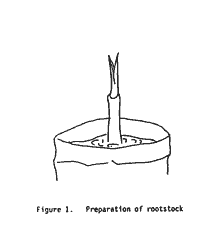
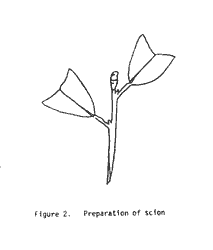
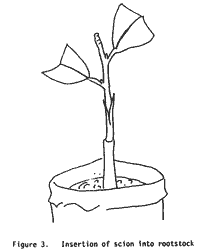
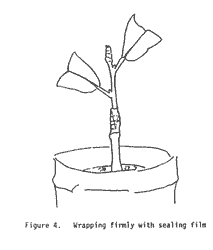
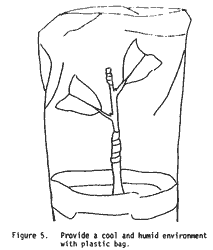
The grafted material is then covered with a plastic bag (Figure 5). Prior to covering, the soil is adequately watered and plants carefully handled to avoid wetting of the grafted parts. The plastic bag cover is removed when the scion starts shooting and this occurs two weeks after grafting. Figure 6 shows a successfully cleft-grafted durian plant at one and a half months after grafting.
This cleft grafting technique can be performed on durian seedlings as young as five weeks old. In contrast, traditional budding requires seedlings which are about four months old. This cleft grafting approach constitutes a more rapid multiplication technique which saves about three months of seedling maintenance costs. Furthermore this technique ensures production of better quality planting materials with lower incidence of 'root circling' in polybags, resulting in improved field establishment.
Cleft grafted durian plants appear to possess a more erect plant form as compared to traditional budded materials which require staking during the early phase of field establishment.
![]()
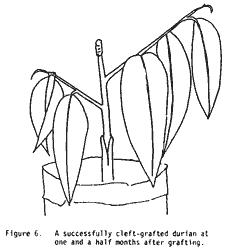
Side-Cleft Grafting Technique: Mango, soursop, star fruit and citrus can be successfully propagated by this grafting technique. This technique offers many advantages over that of budding. Firstly, it can be performed throughout the year and on rootstocks of various ages. Secondly, the side-cleft grafted trees are observed to be more vigorous in growth than that of the budded plants.
Technique of Side-Cleft Grafting of Mango: Healthy seedlings of about ten weeks old are selected as rootstocks. A slanting cut of about 3cm is made on the rootstock (Figure 7). Healthy terminal shoots of about 8 - 18cm are selected as scions. The leaves are all removed and a similar slanting cut of about 3cm is made on one side of the scion while a shorter cut (1cm) is also made on the opposite side of the scion (Figure 8). This prepared scion is then inserted into the rootstock with the longer cut surface facing inside and making sure both cut surfaces are in good contact (Figure 9). Budding tape is used to wrap around the grafting region as well as the whole scion (Figure 10). This is to prevent the scion from dehydration by providing a more humid environment. The budding tape is removed up to the union and the seedling rootstock is cut back about three weeks after grafting. Complete removal of budding tape is done at six weeks after grafting.
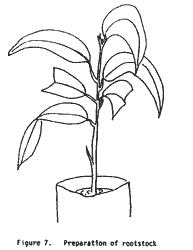
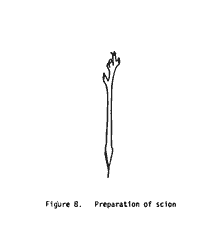
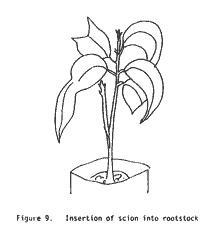
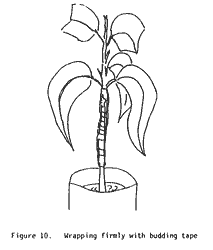
Saddle Grafting Technique: In mangosteen, the traditional method of propagation is by seeds. These apomictic seedlings are true-to-type but possess a long juvenile phase of about 10-15 years. Vegetative propagation provides a means of shortening this phase. Among several vegetative propagation techniques tested on mangosteen, cleft grafting was found to be the most promising (CHONG and AZIZAR, 1984). However, the time taken to prepare cleft-grafted materials is about one and a half years, which is considered too long. Recent studies have shown that saddle grafting technique developed for cocoa, (KRISHNAN, AHMAD, AHMAD AND OSMAN, (1988) is also suitable for mangosteen propagation. In saddle grafting of mangosteen, five-month-old seedling rootstocks are used where 85% grafting success is common.
Technique of Saddle Grafting on Mangosteen: A well maintained five-month-old seedling with a height of 10-15cm is selected as rootstock. The seedling is then lopped-off at a height of 4cm and all the leaves are removed. Two cuts (about 1.5cm each) are made on opposite sides of the stem so as to form a tapering wedge (Figure 11).
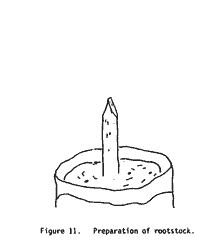
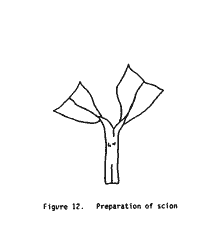
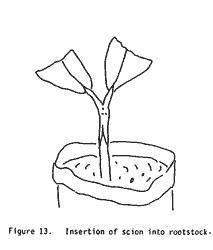
A healthy terminal mangosteen shoot with two leaves (about 5cm) obtained from a matured tree is selected as scion. The two leaves on the scion are trimmed to reduce transpiration loss. A clean razor cut of about 1.5cm is then made on the base of scion (Figure 12). The prepared scion is then placed on top of the previously prepared rootstock making sure that at least one side of the cambium is aligned (Figure 13) and wrapped firmly with sealing film to ensure good contact (Figure 14).
The grafted plant is then covered with a plastic bag which helps to keep the humidity high (Figure 15). Prior to covering, the soil is adequately watered and plants carefully handled to avoid wetting the grafted parts. The plastic bag is subsequently removed when the scion starts shooting and this normally occurs about one month after grafting. Figure 16 shows a successfully saddle-grafted mangosteen plant with two new leaves.
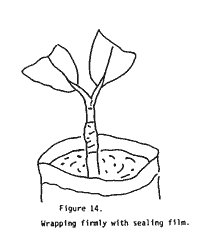
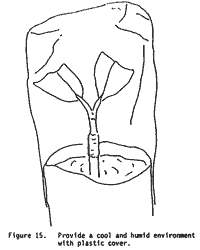
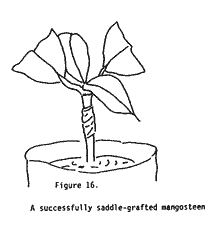
Stem Cutting: Although propagation by cutting has numerous advantages, it is rarely used for tropical fruit trees (GARNER and CHAUDRI, 1976). Indeed, for easy-to-root fruit trees, this method is the cheapest, simple and a rapid way of producing large quantities of uniform clonal planting materials. Attempts have been made by MARDI to develop cuttings for propagation of some of our local fruits. Research carried out recently has demonstrated that duku langsat which is traditionally propagated by seeds, marcotting and approach grafting can also be propagated by stem cuttings.
Cutting Propagation Technique of Duku Langsat: In propagating duku langsat by stem cuttings, hardwood cutting are obtained from mature, dormant terminal shoots from healthy stock plants. The cutting which is about 20cm long and 0.8cm in diameter should have at least three to four nodes and two to four leaflets on the upper portion of the cutting. The basal cut is made just below a node. Large leaflets should be trimmed to reduce the transpiration loss and space requirement in the propagating bed. The cuttings are then given wounding treatment before they are dipped in rooting hormone solution of IBA (indolebutyric acid) at 10,000 ppm concentration for a few seconds. The hormone is allowed to dry before the cuttings are inserted into the rooting medium of coarse river sand in a heavily shaded mist spray plastic house. Rooting of cutting will normally occur 70 to 80 days after sticking the cutting into the sand bed.
As shown in Table 2, the percentage of rooted cuttings vary from 55% to 90% for the clones studied. The source of the materials or clones seem to have some effect on the rootability of cutting. It is possible that cuttings from different clones may have different requirements for root initiation.
Table 2
Variation in rooting percentage and number of roots per rooted cutting for different Duku Langsat clones
| Cutting source (clone) | % of cuttings rooted* | Mean No. of roots/rooted cutting |
| ST (4) | 75 | 2.2 |
| PG (2) | 55 | 1.9 |
| AP (1) | 70 | 3.1 |
| AP (2) | 90 | 1.9 |
| JAP (2) | 60 | 2.5 |
| JAP (2) | 70 | 2.8 |
* % of cuttings rooted was based on 40 samples.
CONCLUDING REMARKS
The development of cleft grafting technique for durian, cashew, nangka and cempedak has not only saved considerable amount of time and costs in the nursery stage but also produced good quality planting materials with minimum root problems. In mangosteen and duku langsat which have long juvenility, the technique of grafting using scions taken from mature trees can possibly shorten juvenility considerably. In fact, a few cleft-grafted mangosteen plants have flowered and fruited about two and a half years after grafting. Moreover, the cleft grafted plants are more vigorous, have better tree form and have less establishment problems than the traditional budded or marcotted plants.
Research in the development of propagation by cutting for local fruits have consistently met with difficulties. But more recently, the use of growth regulators, especially IBA, at high concentration and intermittent mist propagation system have improved the prospects of propagating fruits by cuttings. Success in propagating duku langsat by cuttings should encourage more farmers to cultivate this fruit type especially if they are going to bear earlier than seedlings. In the past, the problems of obtaining seeds plus poor seed germination and the very slow-growing nature of the duku langsat, has impeded the cultivation of this crop. With this development of cutting propagation, hopefully the popularity of this crop will pick up very soon.
Another important aspect of cutting propagation is the possibility of having clonal rootstock for local fruits. The important role played by rootstock in the growth and development and subsequent production of fruit trees has been overlooked. More emphasis should be given to developing this propagation technique as well as the development of clonal rootstock for specific fruit types.
The techniques of cleft and side-cleft grafting developed mainly for multiplication of planting materials, can also be applied in the rehabilitation of unproductive fruit trees by topworking. Topworking provides a fast means of changing the clones without replanting. The cleft and side-cleft grafting techniques have been successfully used in topworking cashew and mango respectively.
ACKNOWLEDGEMENTS: The authors wish to thank the Director and Deputy Director of Fruit Research Division, Dr. Abd. Wahab Ngah and Dr. Abd. Razak Shaari respectively for their encouragement and support in the preparation of this manuscript.
DATE: May 1990
* * * * * * * * * * * * *
